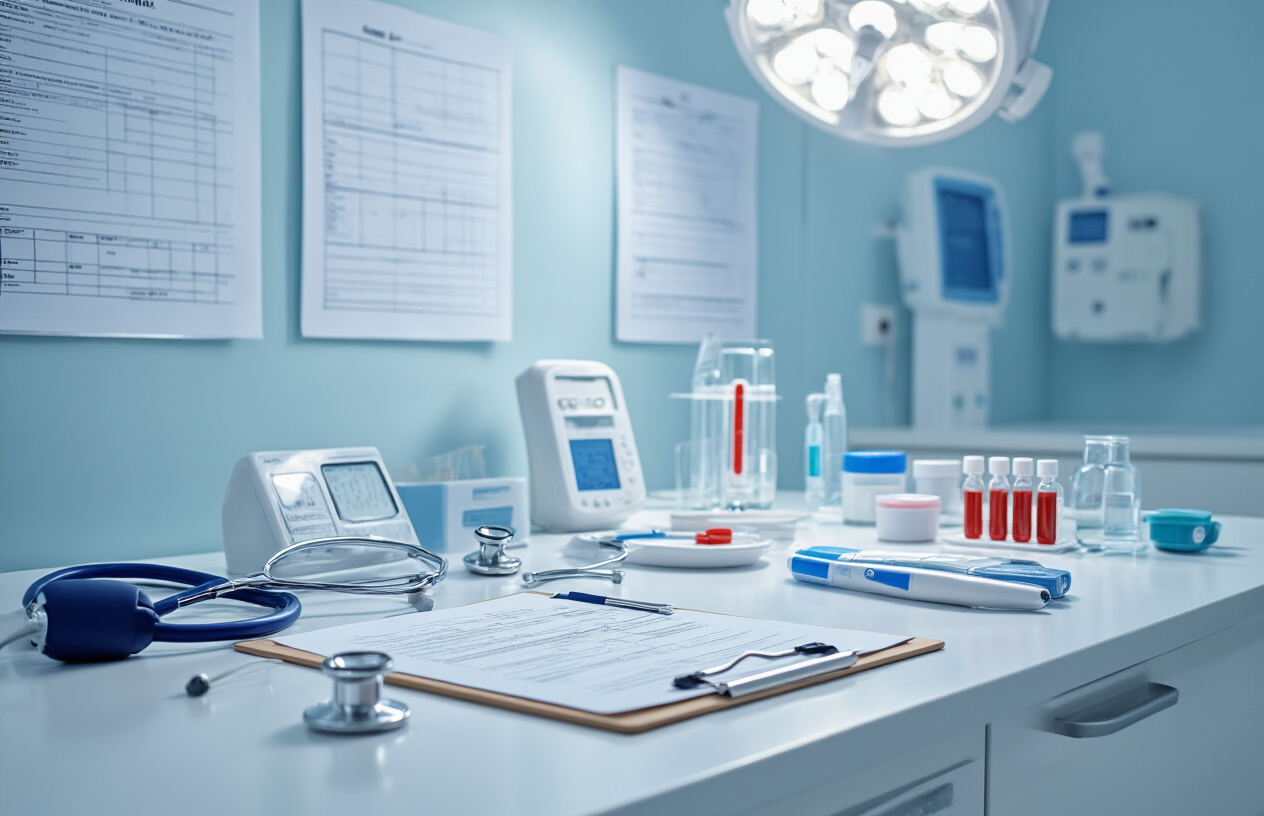Regular health checkups are one of the most important investments you can make in your long-term wellness, but figuring out the right frequency can feel confusing. This guide is for anyone wondering how often they should see their doctor – whether you’re a healthy young adult, approaching middle age, or managing chronic conditions.
The answer to “how often should you get a health checkup” isn’t one-size-fits-all. Your age, health status, and risk factors all play a role in determining the ideal schedule. While younger, healthy adults may only need checkups every one to three years, those over 45 typically benefit from annual visits.
We’ll break down the recommended checkup frequency by age and health status, so you know exactly when to schedule your next appointment. You’ll also discover what essential health screenings and tests to expect during your visit, helping you maximize the value of each checkup. Finally, we’ll explore your insurance coverage options and affordable alternatives if you’re uninsured, because everyone deserves access to quality preventive care.
Understanding Recommended Checkup Frequency by Age and Health Status

Every 1-3 years for healthy adults under 45
For adults in their 20s and 30s, comprehensive physical exams are recommended annually, including blood pressure screening, cardiovascular evaluation, and depression screening. However, certain tests like cholesterol checks can be performed every 5 years, while blood sugar tests and eye exams may be conducted every 2-5 years as recommended by your primary care provider, allowing for a more flexible checkup schedule.
Annual checkups for adults 45 and older
Adults entering their 40s should maintain annual comprehensive physical exams while adding age-specific screenings. Women require yearly mammograms and full-body skin exams, while men need annual full-body skin exams. Cholesterol monitoring becomes more frequent, transitioning from every 5 years to every 2-5 years for women and annually for men in their 50s.
More frequent visits for chronic disease management
Individuals with existing health conditions require personalized screening schedules beyond standard recommendations. Those with risk factors for heart disease, diabetes, or cancer may need more frequent blood pressure monitoring, blood sugar tests, and specialized screenings. Your primary care provider will determine the appropriate frequency based on your specific condition severity and treatment response.
Personalized scheduling based on risk factors
Health checkup frequency should be tailored to your generational health risks and family history. Gen Z faces risks like cervical cancer and mental health issues, while Millennials encounter reproductive difficulties and stress-related conditions. Gen X and Baby Boomers require increased monitoring for breast cancer, colon cancer, heart disease, and high blood pressure, necessitating more frequent preventive screenings.
Essential Health Screenings and Tests During Checkups

Universal screenings for blood pressure, diabetes, and depression
Essential health screenings form the foundation of preventive care, with universal tests recommended for all adults regardless of age or gender. Blood pressure monitoring should occur annually as part of your comprehensive physical exam, helping detect cardiovascular risks early. Depression screening is now recognized as a critical annual assessment that can identify mental health concerns before they become severe. Blood glucose testing, typically performed every 2-5 years, serves as the primary screening tool for diabetes detection. These three fundamental screenings—along with annual BMI measurements and cardiovascular evaluations—create a baseline picture of your overall health status.
Age-specific cancer screenings including colorectal and lung
Previously establishing universal screenings, age-specific cancer screenings become crucial as risk factors increase with time. Colorectal cancer screening is recommended every 10 years for appropriate age groups, representing one of the most effective preventive measures for detecting this common cancer early. Lung cancer screening is specifically recommended for individuals with a smoking history, as this targeted approach focuses on the highest-risk population. These screenings complement the annual skin cancer screenings that are part of routine preventive care protocols.
Gender-specific tests for women including mammograms and Pap smears
With universal and age-specific screenings covered, women require additional gender-specific preventive care measures. Mammography for breast cancer detection should occur every 1-2 years, serving as the primary screening tool for early breast cancer identification. Annual clinical breast exams complement mammographic screening as part of comprehensive women’s health care. Cervical cancer screening, commonly known as Pap smears, is recommended every 2-5 years depending on individual risk factors and previous results. These screenings work together with routine well-woman exams to provide comprehensive preventive care tailored specifically for women’s health needs.
Gender-specific tests for men including prostate and aneurysm screening
Now that women’s specific screenings have been addressed, men have their own set of targeted preventive health measures. Prostate cancer screening becomes an important consideration as men age, though the frequency depends on individual risk factors and physician recommendations. Annual testicular cancer screening is recommended as part of routine men’s preventive care. Abdominal Aortic Aneurysm screening is specifically recommended for men who have a smoking history, as this population faces significantly higher risk. These male-specific screenings complement the universal health measures to create a comprehensive preventive care approach designed for men’s unique health risks.
Maximizing the Value of Your Physical Examination

What to expect during a complete physical exam
A complete physical examination covers comprehensive health assessments including vital signs measurement (blood pressure, heart rate, respiratory rate, blood oxygen level, and weight), disease screening, vaccination administration when needed, and evaluation of overall mental and physical well-being. Healthcare providers conduct routine tests such as diabetes screening, cholesterol screening, hearing and vision tests, and screening for depression and anxiety. The examination also includes reviewing personal and family medical history, discussing current symptoms or health concerns, and assessing lifestyle factors like exercise habits and diet. Depending on age, gender, and health status, additional screenings may be performed – women receive clinical breast exams and pap smears, while men may be screened for prostate cancer.
Preparing your medical history and medication lists
Effective preparation requires gathering comprehensive medical information before your annual physical exam. Create a detailed list of all current medications including names, dosages, and whether they’re prescribed or over-the-counter, plus vitamins and supplements. Document your complete medical history including chronic conditions like diabetes and high cholesterol, past surgeries, previous cancers (even if resolved), and any allergies with specific reactions experienced. Family history is equally important – note medical problems in parents, grandparents, and relatives, particularly conditions with genetic components like heart disease, cancer, and diabetes. Include vaccination records, as adult vaccines need maintenance and updates. Having this information readily available ensures your healthcare provider can make accurate assessments and appropriate screening recommendations.
Communicating effectively with your healthcare provider
The most effective appointments occur when patients are prepared, honest, and forthcoming about their health concerns. Write down questions and symptoms beforehand to avoid forgetting them during your visit, and bring pen and paper to take notes about recommended screenings and tests. Be completely candid about sensitive topics including sexually transmitted diseases, mental health issues like depression, alcohol consumption, and smoking habits – accuracy in these areas is crucial for proper care. Discuss your lifestyle thoroughly, including exercise habits, dietary restrictions, and work situation, as this information helps providers offer appropriate counseling and identify potential vitamin deficiencies. Ask questions about anything you don’t understand, whether it’s about screening recommendations, test results, or healthy living strategies.
Understanding when additional tests may be needed
Additional testing recommendations depend on your age, gender, medical history, and risk factors identified during the examination. Healthcare providers order specific screenings based on family history – for example, patients with first-degree relatives who had early colon cancer may need colonoscopies before the standard recommended age. Routine blood work typically includes blood count, lipid panel, metabolic panel, and diabetes screening, with age and gender-specific additions like PSA testing for prostate cancer screening in men and TSH testing for thyroid problems. If you experience unexplained fatigue, providers conduct extensive medical history reviews and order targeted blood work to rule out underlying causes. The decision for additional testing is individualized, considering your complete health picture and potential risk factors identified during the comprehensive evaluation.
Understanding Insurance Coverage for Preventive Care

What preventive services are covered without copays
Most health plans must cover a comprehensive set of preventive services at no cost to you, including shots and screening tests. These free services include annual physical exams, vaccines, recommended cancer screenings for breast, colon, prostate, lung and cervical cancer at specific ages, and health screenings for conditions like osteoporosis and diabetes. However, these services are only free when delivered by a doctor or provider within your plan’s network.
Distinguishing between wellness visits and regular appointments
The key difference between preventive and diagnostic care lies in whether symptoms are present. Preventive care includes routine services performed during well exams when you have no symptoms, while diagnostic care involves treatment when you already have symptoms or risk factors. For example, a routine mammogram is preventive, but if a woman finds a lump and gets a mammogram, it becomes diagnostic care with different coverage and costs.
Managing costs for non-preventive tests and services
Not all tests during your checkup qualify as preventive care. While cholesterol screening is covered for adults ages 40-75 and diabetes screening for people ages 35-70 with BMI at or above 25, complete blood counts and tests for kidney function, liver function, vitamin D, or iron levels are generally not considered preventive care and may result in out-of-pocket costs. Always ask your doctor which tests are covered as preventive versus diagnostic.
Medicare wellness visit requirements and benefits
Medicare provides specific wellness visit benefits as part of preventive care coverage, though the reference content doesn’t detail specific Medicare requirements. Like other health plans, Medicare covers eligible preventive care services without copays when provided by in-network providers, emphasizing the importance of understanding which services qualify for full coverage versus those that may incur costs.
Finding Affordable Healthcare Options Without Insurance

Community health centers and federally qualified clinics
Community health centers provide an excellent solution for affordable health checkups when you lack insurance coverage. These centers offer low-cost health care with payment based on your income level, making routine medical checkups accessible regardless of your financial situation. Located in both urban and rural areas, they provide comprehensive services including prenatal care, baby shots, general primary care, and referrals to specialized care such as mental health, substance abuse, and HIV/AIDS treatment.
Free clinics and charity care programs
While the reference content mentions community health centers as affordable options, specific information about dedicated free clinics and charity care programs is not detailed in the provided materials. However, these centers operate on sliding fee scales based on income, making them effectively function as charity care for those with the lowest incomes.
Healthcare marketplace options and financial assistance
The Healthcare Marketplace offers significant opportunities for affordable health checkups through income-based savings programs. Most people qualify for cost savings based on household size and estimated annual income, making Marketplace plans more affordable than many realize. A single application determines eligibility for both Marketplace health plans and Medicaid coverage, with savings calculated regardless of employment status.
Payment plans and discount programs for uninsured patients
Community health centers inherently function as discount programs for uninsured patients by adjusting costs according to income levels. The reference content emphasizes that payment amounts depend directly on your income, creating an automatic discount system for those who cannot afford standard healthcare pricing for their preventive health screenings and routine checkups.
Evaluating the Current Debate on Annual Physical Necessity

Scientific evidence questioning yearly checkup effectiveness
Recent research published in The New England Journal of Medicine challenges the traditional belief in annual physical exams. Careful reviews of large studies demonstrate that yearly visits don’t improve health outcomes or help people live longer. Despite professional guidelines recommending against routine annual exams, both doctors and patients remain strongly committed to this practice, with surveys showing majority support for continuing these visits.
Potential risks of routine testing in healthy individuals
Laboratory tests and examinations ordered for healthy patients carry statistical risks of producing false positives – results suggesting problems that don’t actually exist. While these inaccurate findings affect only a small percentage of the over 200 million adults undergoing annual exams, the associated monetary, practical, and emotional costs are substantial, potentially causing more harm than benefit.
Alternative models focusing on relationship-building visits
Healthcare experts propose a new visit model specifically designed to strengthen doctor-patient relationships. This approach would include initial visits for new patients to establish rapport and routine relationship-maintenance visits every three years or so. The emphasis would shift toward comprehensive medical and social history discussions rather than extensive physical examinations or screening laboratory tests.
Shifting toward proactive preventive care monitoring
The proposed healthcare model advocates for “active engagement” rather than the current “passive” approach of waiting for annual visits. Recommended strategies include online risk assessments, waiting-room questionnaires, and reviewing preventive care during any doctor visit. This proactive monitoring system would ensure patients receive appropriate screenings while allowing primary care physicians to redirect time toward addressing urgent needs and expanding healthcare access.

Regular health checkups remain a cornerstone of preventive care, though the frequency should be tailored to your individual circumstances. For adults under 45 in good health, checkups every one to three years are generally sufficient, while those 45 and older benefit from annual visits. If you have chronic conditions like diabetes or heart disease, more frequent monitoring is essential regardless of age. The key is working with your healthcare provider to determine the right schedule based on your risk factors, family history, and current health status.
Taking charge of your health means being proactive about both scheduling appropriate checkups and maximizing their value. Come prepared with updated medication lists, questions prioritized by importance, and honest communication about your lifestyle and concerns. Remember that preventive services are typically covered by insurance without copayments, making regular care more accessible. Whether you have insurance or need to explore affordable care options through community health centers and free clinics, the investment in preventive care pays dividends in early detection, better health outcomes, and reduced long-term healthcare costs. Your health is your most valuable asset—make informed decisions about when and how often to invest in professional medical guidance.